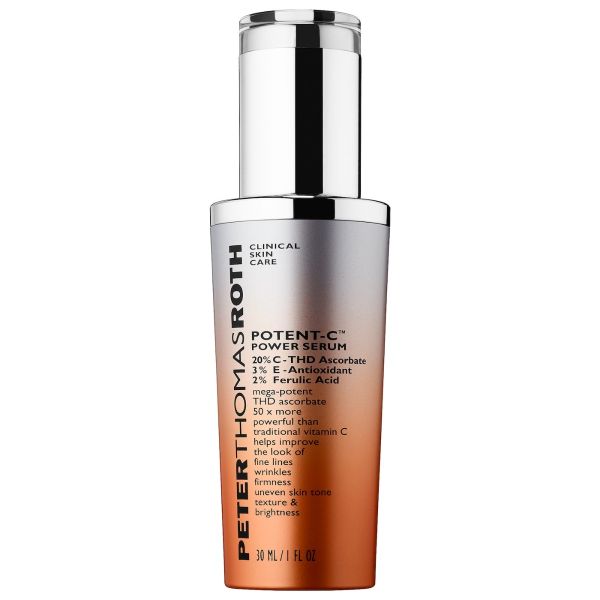Potent skin care serum with 20% THD ascorbate - a powerful, more concentrated alternative to traditional vitamin C
THD ascorbate is scientifically-proven to be more stable and better absorbed by the skin Formula also contains potent concentration of 3% vitamin E for heightened antioxidant activity Concentrated 2% ferulic acid further enhances THD ascorbate and vitamin E stability Key ingredients promote firmer, brighter, and more youthful-looking skin Moisturizing serum reduces the appearance of wrinkles, fine lines, rough texture, dull skin, uneven skin tone, and other signs of aging Made in the USA Fragrance free Paraben free
Ingredients Concern: Phenoxyethanol (safe in small amounts)
Cons: The combination of certain ingredients such as ginger, turmeric, ginseng, and jojoba may create a smell that is unpleasant for some users (description list the product as fragrance free, but several users reported that the product has a strong scent)
THD ascorbate or Tetrahexyldecyl ascorbate is a more stable form of vitamin C than ascorbic acid [1]. In addition, THD ascorbate is fat-soluble, which means that this type of vitamin C readily dissolves in oil-based skin care products [1]. Due to its fat-soluble components, THD ascorbate also penetrates the skin better than traditional vitamin C [1]. Conversely, skin care products with ascorbic acid are not as effective because this type of vitamin C is water-soluble and easily dissolves in water. Ascorbic acid is also very unstable and oxidizes upon exposure to the air, water, and sun, making it necessary to package this ingredient in dark, air-tight containers. These features are not always feasible for skin care products, meaning products with ascorbic acid may not be very effective, especially if this ingredient is not combined with vitamin E and ferulic acid [2].
The combination of vitamin C in the form of THD ascorbate (20%) along with vitamin E (3%), and ferulic acid (2%) (stabilizing agent) helps boost the body's natural skin cell rejuvenation processes [1-3].
Anti-aging [1, 2], skin firming, moisturizing, brightening, and blemish reduction [1-5], targets fine lines, wrinkles, and discoloration [1, 2]
THD ascorbate at a concentration of 20% can penetrate through the epidermis (outermost layer of the skin) and the dermis (layer directly underneath the skin's surface) better than ascorbic acid [1]. The penetration rate of THD ascorbate is dose dependent, but it still surpasses the penetration of ascorbic acid by three times when both forms are used at the same concentration. Furthermore, THD ascorbate maintains a higher penetration rate even when the concentration of ascorbic acid is 25 times that of THD ascorbate [1]. Due to these beneficial properties, the use of THD ascorbate demonstrates enhanced stability in serums as well as substantial differences in facial wrinkles, hydration of dry skin, collagen production, and skin brightening [1].
Blending vitamin C (20% THD ascorbate) with vitamin E (3%), and ferulic acid (2%) for added stability, supports healthy levels of inflammation and has skin-smoothing as well as photoreceptor enhancing properties [1, 2]. Ferulic acid is frequently added to skin care products due to its photoprotective, anti-aging, skin-brightening, and ingredient-stabilizing properties [3]. It also helps reduce the appearance of fine wrinkles and skin discoloration [2, 3].
Additional ingredients such as squalene, sodium hyaluronate, turmeric, and jojoba also help hydrate the skin and promote moisture retention [4, 5].
Note regarding the Strength, Results, and Safety: The percentages of the key ingredients should provide noticeable benefits for the skin. Furthermore, research shows the efficacy of combining vitamin C, E, and ferulic acid (as an ingredient carrier) for anti-aging activity and a reduction of fine lines, wrinkles, and additional signs of aging. In terms of safety, phenoxyethanol has an EWG rating of 4, depending on its usage, while all of the other ingredients have EWG ratings of 1. Phenoxyethanol is the last ingredient, but the percentage is not listed and this makes it hard to determine the safety of this particular ingredient in the serum.
Key Ingredients: 20% THD ascorbate, 2% Ferulic acid, 3% vitamin E
All Ingredients: Water / Aqua / Eau, Tetrahexyldecyl Ascorbate, Butylene Glycol, C9-12 Alkane, Caprylyl Methicone, Tocopheryl Acetate, C10-18 Triglycerides, Polyglyceryl-6 Distearate, Ferulic Acid, Squalane, Propanediol, Sodium Hyaluronate, Zingiber Officinale (Ginger) Root Extract, Curcuma Longa (Turmeric) Root Extract, Panax Ginseng Root Extract, Jojoba Esters, Leuconostoc/Radish Root Ferment Filtrate, Coco-Caprylate/Caprate, Glycerin, Cetyl Alcohol, Polyglyceryl-3 Beeswax, Xanthan Gum, Disodium Edta, Mica, Ethylhexylglycerin, Potassium Sorbate, Sodium Benzoate, Phenoxyethanol 
Apply 1-2 pumps to clean, dry skin. For best results, use twice daily on face, neck and back of hands. For external use only.
These statements have not been evaluated by the FDA. These products are not intended to diagnose, treat, cure or prevent any disease.
1. Fitzpatrick RE, Rostan EF. Double-blind, half-face study comparing topical vitamin C and vehicle for rejuvenation of photodamage. Dermatol Surg. 2002;28(3):231-6.
2. Murray JC, Burch JA, et al. A topical antioxidant solution containing vitamins C and E stabilized by ferulic acid provides protection for human skin against damage caused by ultraviolet irradiation. J Am Acad Dermatol. 2008;59(3):418-25.
3. Bezerra G, Pereira M, Ostrosky E, Barbosa E, Moura M, Ferrari M, Aragão C, Gomes A: Compatibility study between ferulic acid and excipients used in cosmetic formulations by TG/DTG, DSC and FTIR. J Therm Anal Calorim 2017;127:1683-1691.
4. Bukhari SNA, Roswandi NL, et al. Hyaluronic acid, a promising skin rejuvenating biomedicine: A review of recent updates and pre-clinical and clinical investigations on cosmetic and nutricosmetic effects. Int J Biol Macromol. 2018;120(Pt B):1682-1695.
5. Pazyar N, Yaghoobi R, et al. Jojoba in dermatology: a succinct review. G Ital Dermatol Venereol. 2013;148(6):687-91.


